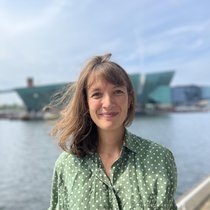Major energy transformations required for a climate neutral city
The City of Amsterdam has the ambition to become climate neutral by 2050. Therefore, Amsterdam has set a number of energy ambitions, for example, to reduce CO2 emissions by 95% by the year 2050.
Other goals are to eliminate the use of natural gas by 2040, phase out fossil fuels by 2050, and have 80% of the electricity that households use to be generated by solar and wind energy in 2030.
Energy-saving measures for the city’s monumental area
To meet these energy ambitions, it is crucial to define a long-term strategy for the inner city – this area has the highest heat demand density in Amsterdam. Recently, the City developed scenarios to replace natural gas as the primary source for heating in the different neighborhoods of Amsterdam.
For the historic inner center, Amsterdam focuses on a 70% gas reduction in 2040 and to use biogas and hydrogen in combination with hybrid solutions for the remaining.
“Since historic buildings constitute a considerable share of the city centers’ building stock, the challenge is to develop energy retrofit approaches and solutions that preserve Amsterdam's historic buildings.”
Paul Voskuilen
Program Developer
“Resources like biogas and hydrogen are limited, expensive, and dependent on regional production, conversion, and transport capacities. Therefore, we are working on a multi-annual research program to support the City in identifying energy-saving measures for this monumental area.”
Maéva Dang
Research Engineer
Sustainable heating solutions that are available locally
With this project, we explore what energy retrofitting solutions can be developed that have the biggest impact in terms of sustainable energy while at the same time preserving the city’s historic and aesthetic values.
By identifying key recommendations and collective measures, the idea is to propose a generic approach on energy retrofit decisions. More specifically, we want to focus exclusively on sustainable heating solutions that are available locally.
Could Amsterdam canals cool off or warm up historic buildings?
This project investigates, among others, if the inner city fulfils the conditions for the implementation of low temperature district heating. And if not, what could we improve to allow for this in the future?
Also, we explore opportunities for synergies with alternative heat solutions such as thermal energy, residual heat and other forms of low temperature in the historic center. To illustrate, regarding aquathermal solutions, it is possible to convert temperatures from surface water, wastewater and drinking water into energy.
Potential for thermal energy from surface water in Amsterdam (Waternet, 2021).
“Aquathermal energy from surface water could be a feasible alternative to natural gas in Amsterdam, since this city counts a large number of canals and open water.”
Maéva Dang
Research Engineer
An innovative canal wall that includes a heat exchanger
Next to developing solutions to take on the energy transition, the City of Amsterdam has the challenge of renovating up to 200 kilometers of historic quay walls. Due to their age – these quays can be up to 300 years old – and changed conditions, many quay walls are to be considered as sub-standard, and potentially unsafe.
Together with TU Delft, as part of another research project we assist the City in developing technical solutions to better our understating of the structural and shallow subsurface conditions affecting the behavior of historical quay walls.
A promising concept this project investigates is the implementation of an innovative canal wall that includes a heat exchanger that can be connected to a heat pump system. The heat from the canal water would be collected in the summer, stored in the subsurface, to use it in the winter when Amsterdam is heating itself. Such sustainable heating technology has not yet been used in a historic city center.
Investigating the implementation potential of this new type of canal walls offers opportunities to tackle multiple urban challenges in Amsterdam at once: implementing urban energy solutions while restoring the city’s canals.

An innovative canal wall that includes a heat exchanger
In collaboration with the Green Light District
The 'High hanging fruit' project contributes to develop knowledge for a large-scale application in Amsterdam. At first, the project starts in collaboration with the Green Light District (webpage in Dutch) but ultimately, the goal is to propose tailored retrofit solutions for the entire historical center of Amsterdam and urban areas alike.
Research output
Find research output of this project here.
Principal Investigators
Project members
Partners







